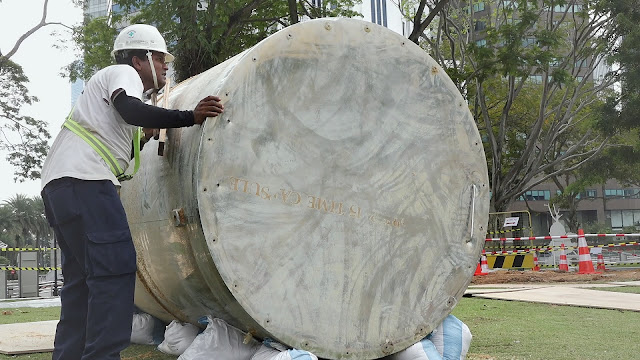Tan Pin Pin, Singapore’s leading documentary filmmaker, is
back with In Time to Come (2017), her
first feature film in four years. However, reviewers would be remiss to discuss
this new film without exploring its quietly anticipated role in Tan’s career. In Time to Come is Tan’s most notable
follow-up to two major turning points in her film career. The first took place
when her previous feature, To Singapore
with Love (2013), was denied all screenings here—a first in Tan’s filmography—for
its depiction of political exiles from Singapore. The second arrived when she
made her first fictional film, ‘Pineapple Town’, as part of the official SG50 omnibus
film 7 Letters (2015). In the wake of
these two events—a banned documentary, a government-funded fictional short—curious
onlookers may have wondered what full-length documentary Tan would attempt next,
once she chose to step back into the form.
The answer might seem to be a return to the basics, if her
new film is any indication. In Time to
Come is structured around the exhuming of one time capsule and the sealing
of another, which means it reprises the themes of remembrance, archival and
nationhood that run through all of Tan’s work. In the film, we bear witness to
the rituals—some mundane, some downright strange—that surround the making and
unmaking of a time capsule. On the front lawn of the Asian Civilisations
Museum, a hulking silver drum is raised slowly from the dirt, with bystanders
snapping photos or asking for the serial number to buy 4D. In a basement with
blank white walls, a massive foiled bag sits like a half-cooked soufflé,
waiting to be ripped open. Various items (a shuttlecock, a papier-mâché lion’s
head, a signed SIM vest) are carefully wrapped in crinkly paper.
Tan presents
these scenes without commentary, offering viewers less of an educational tour
behind the scenes, and more of an opportunity to raise questions about this
unusual practice: Who gets to decide what goes into a time capsule? Why commit to all
this work, for items that might be seen as mere historical curios? (These are questions, too, that hover around Tan’s own work.) In Time to Come
thus aspires not to the narrational or talking-heads style of Tan’s classic
documentaries ‘Moving House’ (2001) or Singapore
GaGa (2005). Instead, it embraces the more free-associative approach of
‘The Impossibility of Knowing’ (2010) and ‘Snow City’ (2011), asking its
viewers to allow its scenes to speak for themselves.
Moreover, as we have come to expect from Tan, the film is
hardly a straightforward archive of the practice of time capsuling. Even in Singapore GaGa—Tan’s most clear-cut
documentary feature—viewers had to acclimatise themselves to her eclectic way
of collecting avant-garde pianists, roadside tissue-sellers and an MRT
voiceover artiste to form her own inimitable portrait of Singapore’s unacknowledged
soundscapes. Here, in In Time to Come,
Tan pairs the scenes of time-capsuling practices with various mundane rituals
of Singaporean life, but capturing what is absurd about them through her choice of camera placement or shot length. We watch as Kinokuniya staff members stand stock-still at the store’s entrance, trying to greet prospective customers to the tune of Vivaldi's Four Seasons, as the latter duck in under the store's rising shutters and stalk quickly past them. We hear a declaration that the Marina Coastal Expressway is now open, not from its opening ceremony, but from a view of its empty, cavernous expanse. Then we cut to the ceremony, but only after it has ended, the floor littered with confetti that will have to be cleaned up.
At other moments, such ritualistic scenes take on a more otherworldly hue. The branch of a giant tree is sawed off, and we hear the machinic groan of the crane holding it as it swings down like an operatic chandelier. Clouds of fumigation rise from mildewed flats, or clear slowly to reveal an underground carpark. Even in these scenes, Tan never allows her film to become ponderously self-serious. She will cut from a fumigation scene to an overhead view of a cityscape blanketed in haze: an irreverent visual association that will draw chuckles from knowing viewers, even as others might take in this impossible sight of a citywide insecticide fuming with a sense of awe. In other words, Tan never allows her scenes to settle into one-note interpretations, even when she minimises the presence of voices within them, or eschews any form of explicit commentary altogether.
We can expect no less from the filmmaker who inspired even our Prime Minister to a rare act of film criticism. Speaking of To Singapore with Love in 2015, PM Lee Hsien Loong contrasted “documentary history, objectively presented” with “self-serving personal account[s], conveniently inaccurate in places, glossing over facts in others.” Without any fuss or furore, In Time to Come reminds us that all histories, however objectively presented, are moored to the perspectives of their makers—whether in time capsules or on film. All we can ask is that these perspectives are as complex, witty and invested as the one that Tan Pin Pin offers us in her latest film.
Film: www.intimetocome.com
Director: www.tanpinpin.com
-->



